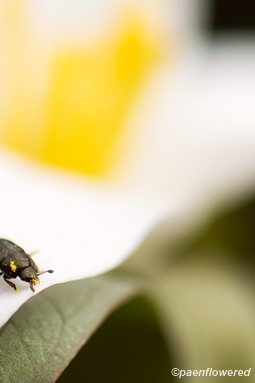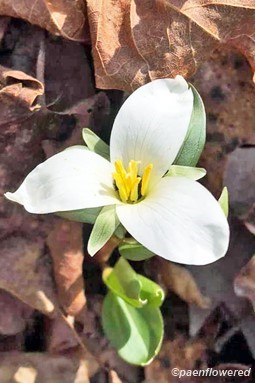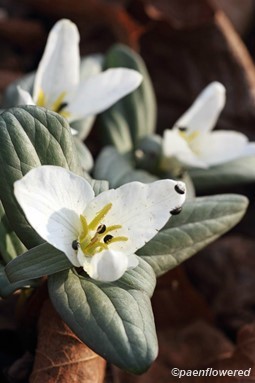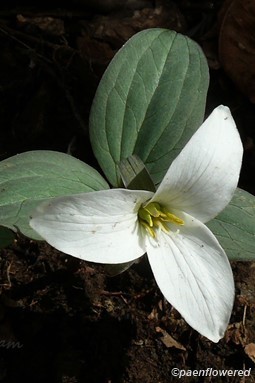Trillium nivale
A rare trillium with snowy white flowers
Trillium nivale snow trillium
As the days warm up, keep an eye out for the rare snow trillium. It is the earliest blooming of several species of trillium that grow in south-western PA. I have seen it blooming from mid-March to mid-April. Often it can be seen growing through a thin layer of spring snow. Often it grows on steep slopes or other hard-to-access areas.
This species is also called the dwarf white trillium because it is the smallest of the local trillium. Like other trillium species it is a perennial. Each plant produces a single white bloom on a short stalk arising between a whorl of three leaves. The flower, when fully open, is about 2 inches in diameter and the 3 petals are narrower than those of other trillium species. On the back of the flower are 3 green sepals. There are six yellow stamens. The leaves are 2-6 inches in length with their base more rounded than their tips.
New plants can grow from the distribution of seeds from the flowers, but they also can put up new sprouts from the growth of the underground rhizome. Thus colonies of this plant are normal. The flowers bloom early, but also wilt early. Only early season hikers are likely to see it. The leaves may persist until midsummer.
The entire plant grows only about 2-4 inches high. The fruit that eventually forms is 3-lobed and about ½ inch long. New plants can grow from the seeds, but more often colonies are spread by the growth of the underground rhizome. The snow trillium grows in rich woods, but prefers limy sandy gravel or crevices in limestone instead of the wet leaf mulch where other trillium species grow. It does best in filtered shade. It is found west of the Appalachian Mountains from western Pennsylvania and Ohio to Minnesota and south to Missouri and Kentucky.
The snow trillium is officially considered a rare plant in Pennsylvania and should not be disturbed when found. Picking the flower will kill the plant and any attempt at transplanting it to another location will probably be unsuccessful. Any found on private land should be protected from deer browsing if possible.
Habitat & Range
Very rare in moist woods, in the south-west.
Present in south-western part of the state.
Range: Found west of the Appalachian Mountains from western Pennsylvania and Ohio to Minnesota and south to Missouri and Kentucky.
Wetland code: Not classified
Phenology
Flowers late March through April.
Plant Codes
PA status: PR (Rare)
S-rank: S2 (Imperiled)
G-rank: G4 (Apparently secure)












Comments
Have you spotted this plant in your area? We'd love to hear about your experience! Share your comments or questions about the plant below. Comments are moderated before posting.